| Alternate |
A mode of branching, in which branches are placed on opposite sides of an axis, at different levels |
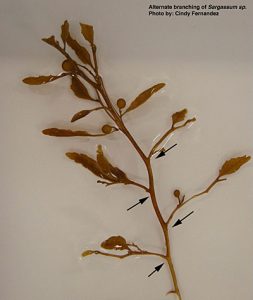 |
| Alterno |
Tipo de ramificación, en la cual las ramas se encuentran en distintos niveles sucesivamente (no opuestos). |
| Alternation of generations |
The succession of two cytologically different phases in the life history of a sexually reproducing plant. One phase produces gametes, and the other, spores. One phase may repeat itself unitl a change of season induces an alternation to the other phase. |
|
| Alternacia de Generaciones |
Tipo de cliclo de vida donde existen dos o más formas alternantes. Una fase produce gametos y la otra esporas. |
|
| Apical |
At or near the apex. Distal. |
 |
| Apical |
Ápice, extremo, punta, terminal, situada en el ápice o extremo anterior, extremo opuesto al órgano de fijación de un alga. |
| Axis |
The main or central line of developmet of a plant, around which the branches (or their analogs) are borne. |
 |
| Axial |
Eje o estructura longitudinal, estos ejes pueden ser uni o multicelulares, según tenga una o varias partes internas componentes. |
| Blade |
The flattened, expanded, foliar portion of a plant. |
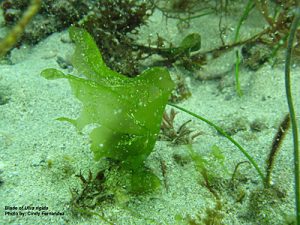 |
| Lámina |
Forma de crecimiento aplanado de un alga. |
| Bladder |
A small bladder containing a variety of gases (nitrogen, oxygen & carbon dioxide) and aiding in the buoyancy of certain plants (e.g. fucoid brown algae); also meaning, intercellular spaces in some algae that serve as floats (cf. aerocyst, air vesicle, gas bladder, pneumatocyst & vesicles) |
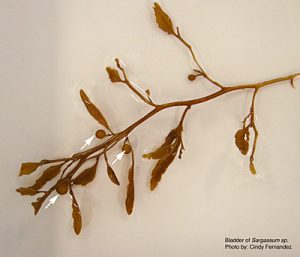 |
| Aerocisto |
Vejiga de aire o flotador, puede contener varios gases (nitógeno, oxigeno, dioxido de carbono, agua). Sinónimo de pneumatocisto. |
| Bleached |
Of a lighter color than is usual. In Rhodophyta especially, plants growing under high light levels may appear straw-colored or tan, rather than red. |
|
| Blanqueado |
De un color más claro que lo usual, que puede implicar la muerte de la planta. Blancuzco, pálido. En Rhodophyta se da especialmente en plantas que crecen bajo condiciones de alta luminosidad causando fotoinhibición. |
|
| Branch |
A plant division subordinate to the main axis, and being used interchangeable with the term lateral; also refers to the graphical representation of an evolutionary relationship in a phylogenetic tree (cf. branched). |
|
| Ramificación |
División del eje principal, para formar ramas o divisiones primarias. Las ramas pueden presentarse desde simples filamentos celulares hasta talos completos. |
|
| Branchlet |
A small secondary or higher-order branch, usually the ultimate branch in a system of branching (cf. ramulus). |
|
| Rama Secundaria |
Ramificaciones que presentan estructuras o ramas laterales o como excrecencias a partir de las ramas primarias. |
|
| Bloom |
A profuse development of algae, not necessarily microscopic, but often involving but one or two species. Usually self-limiting and of short duration. |
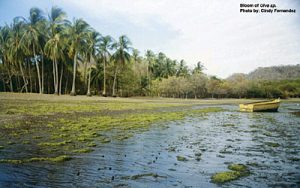 |
| Proliferación |
Incremento de individuos por reproducción repetida y frecuente o por fragmentación. Puede ser de algas macroscópicas o microscópicas y una mezcla de varias especies. Frecuentemente de poca duración. |
| Calcareous |
Impregnated and hardened with lime (calcium carbonate) extracted from the surrounding water. |
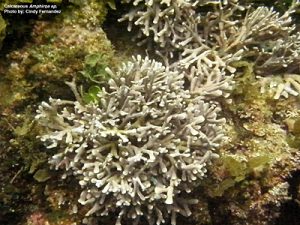 |
| Calcáreo |
Planta que deposita carbonato de calcio en su pared celular ya sea aragonita o calcita. |
 |
|
The female sex organ, consisting of a single cell with a drawn out extension or process, the trichogyne. (Rhodophyta) (Pl: Carpogonia). |
|
| Carpogonio |
Gametangio femenino en Rhodophyta. Célula especializada sexual femenina que contiene al óvulo, célula terminal de una rama o filamento carpogonial que continúa en el tricógino, por donde entrará el espermacio a fecundar para transformarse en un carpoesporangio que originará las carpoesporas y estas a los carpoesporófitos. |
|
| Carposporangium |
Single-celled structures borne on the minute, parasitic carposporophyte generation. The reproductive products are non-motiel carpospores which germinate into the macroscopic tetrasporophyte generation. |
 |
| Carpoesporangio |
Cavidad diploide en un talo haploide (femenino) donde se desarrollan las carpoesporas, que producen el tetraesporófito |
| Carposporophyte |
The gonimoblast filaments and the carposporangia borne on them, plus the carpogonium or the auxiliary cell producing the gonimoblast filaments. (Rhodophyta) Syn. = cystocarp. |
|
| Carpoespórofito |
Fase multicelular diploide del ciclo de vida de las Rodoficeas que resulta de la fecundación de un carpogonio por un espermacio, cuyos filamentos llamados gonimoblástos desarrollan a los carpoesporangios y dentro de estos las carpoesporas. Los carpoesporofitos se desarrollan como cavidades en las plantas gametofíticas que son haploides. |
|
| Cartilaginous |
Fleshy but firm. Not easily compressed, yet bendable. See Laurencia papillosa (Rhodophyta) |
|
| Cartilaginoso |
Forma de crecimiento de constitución densa, firme, homogéneo y elástica. Ver Laurencia papillosa (Rhodophyta). |
|
| Clump |
Type of habit in which the thallus form a close aggregation. |
|
| Agregación |
Forma de organización de los talos donde convergen una o varias especies en forma arbustiva. |
|
| Compressed |
Flattened. |
|
| Aplanado |
Delgado, alisado en la superficie. |
|
| Coenocytic |
Lacking (or with few) crosswall, composed of a multinucleate mass of protoplasm within a tubular wall. |
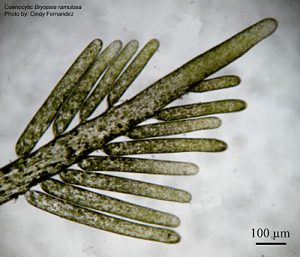 |
| Coenocítico |
Célula o talo multinucleado, que carece de paredes internas transversales que individualicen las células. |
| Conceptacle |
An invagination or cavity (either sunken or within a raised dome) having one or more openings to the thallus surface and bearing reproductive organs. In some Phaeophyta and Rhodophyta. |
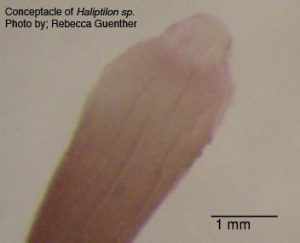 |
| Conceptáculo |
Una cavidad fértil (hundida o en forma de domo), generalmente interna bajo la superficie del talo, pero con una o más aberturas u ostiolos al exterior, donde se forman estructuras reproductivas, se presentan en las algas pardas y rojas. |
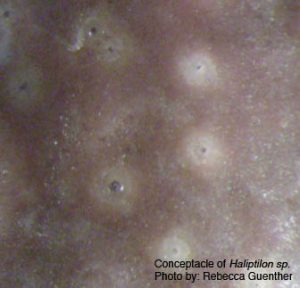 |
| Coralline |
Like coral. Structurally composed of lime (calcium caronate), at least in part. Stoney. |
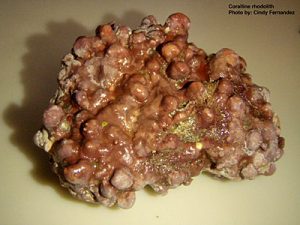 |
| Coralina |
Relativo a coral. Talos fuertemente impregnados con carbonato de calcio |
| Cortex |
The tissue of a more or less solid alga, lying beneath the epidermis, between this and the central tissue, the medulla. |
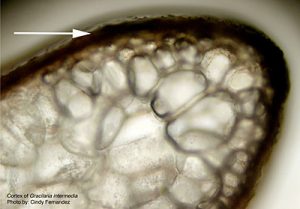 |
| Corteza |
Capa de células o tejido más externo de un talo. Capa entre la epidermis y la médula. Si no existe epidermis, entonces la zona que rodea a la médula o el filamento axial, generalmente formado por células pseudoparenquimatosas pero pigmentadas. |
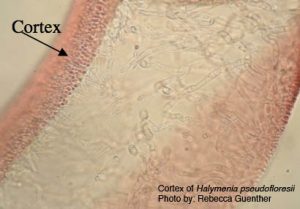 |
| Cortical |
Belonging to or occurring in the cortex. With reference to the cortex. |
|
| Cortical |
Propio o relativo a la corteza. |
|
| Corticated |
With a cortex or outer layer(s) of small cells covering those produced directly by the apical cell. |
|
| Corticado |
Que tiene o está cubierto por una corteza parenquimatosa. |
|
| Corticating |
Forming an enclosing layer. |
|
| Corticando |
Que forma un capa envolvente. |
|
| Cortication |
The secondarily formed outer covering (of cells) of part or all of an algal thallus. |
|
| Corticación |
Segunda capa de células en el talo. |
|
| Crosswall |
The end wall of a cell within a filament. |
|
| Pared trasversal |
Parte distal de una célula dentro de un filamento. |
|
| Cruciate |
In the general shape of a cross. When referred to the red algae, a type of spore division in which the contents of a tetrasporangium are divided in two planes, at right angles to each other. |
|
| Cruzado |
En forma de cruz. |
|
| Crustose |
Crustlike in habit. A thin plant body growing flattened against the substratum. Hard and brittle. |
 |
| Costroso |
Forma de crecimiento totalmente adherido al sustrato. Estructura delgada y aplanada que se encuentra sobre el sustrato. Dura o blanda. |
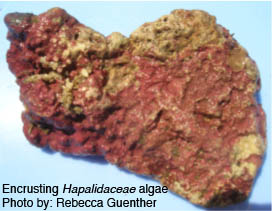 |
| Cystocarp |
The gonimoblast filaments and the carposporangia borne on them, plus the carpogonium or the auxiliary cell producing the gonimoblast filaments (Rhodophyta) Syn. = carposporophyte. |
|
| Cistocarpo |
Termino que se aplica a la cavidad que engloba al carpoesporófito. En las algas rojas un cistocarpo contiene esporas diploides o carpoesporas citoplasmáticas que carecen de paredes internas transversales que individualicen a las células. |
|
| Cystocarpic |
Bearing cystocarps. A term used to distinguish the female plant (Rhodophyta). |
|
| Cistocárpico |
Con cistocarpos. Término usado para distinguir plantas femeninas. |
|
| Dichotomous |
Divided or forked into two equal parts. See Dictyota dichotoma (Phaeophyta). |
|
| Dicotómico |
Tipo de ramificación que resulta de la división de un punto de crecimiento en dos ramas más o menos iguales repitiéndose de manera continua. Las dicotomías pueden ser iguales o irregulares. |
|
| Dichotomously branched |
Branched by repeated forkings. |
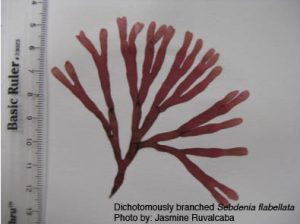 |
| Ramificado dicotómicamente |
Con ramificación dicotómica. |
 |
| Dichotomy |
A paired fork. |
|
| Dicotomía |
Dividido en dos. |
|
| Ecorticate |
Lacking a cortex, or differentiated outer layer of cells. |
|
| Falto de corticación |
Que carece de corteza, con capas de células no diferenciadas. |
|
| Endolithic |
Embedded in or growing within rock. |
|
| Endolítico |
Que crece sobre rocas. |
|
| Endophytic |
Growing within the tissues of a plant, but not necessarily parasitic. |
|
| Endofítico |
Que crece dentro de los tejidos de otra planta, no necesariamente parásita. |
|
| Endozoic |
Living within the tissues of an animal, but not necessarily parasitic. |
|
| Endozóico |
Que vive dentro de los tejidos de un animal, no necesariamente parásita. |
|
| Epilithic |
Growin attached to a rock. SYN.=saxicolous. |
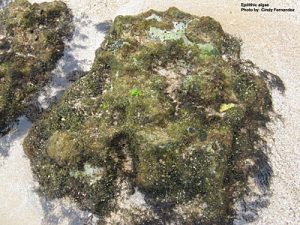 |
| Epilítico |
Que crece adherida a rocas. |
| Epiphytic |
Growing attached to a plant, but not necessarily parasitic. |
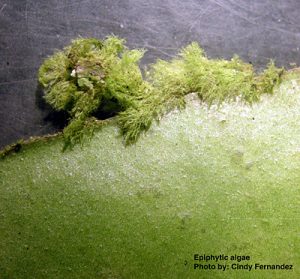 |
| Epífito |
Que crece adherida a otras plantas, no necesariamente parásita. |
| Epiixylous |
Growing upon wood. |
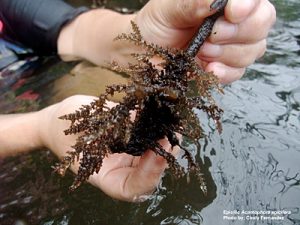 |
| Epixílico |
Que vive o crece sobre madera. |
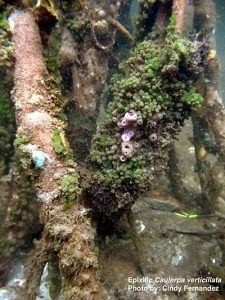 |
| Epizoic |
Growing attached to the outer surfae of an animal. |
|
| Epizóico |
Que crece adherida a la superficie externa de un animal. |
|
| Filament |
An elongate thread, composed of cells attached end to end. In the blue-green algae, the living trichome plus the sheath. |
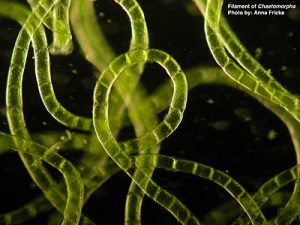 |
| Filamento |
Forma de crecimiento del talo como hilo o como pelo. Desarrollo lineal, de una sola fila de células, que pueden o no presentar ramificaciones. |
| Filamentous |
Threadlike. |
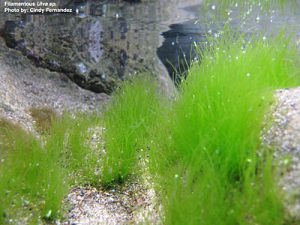 |
| Filamentoso |
Forma de crecimiento con forma de hilo. |
| Fleshy |
Succulent, soft and smooth in texture, or somewhat cartilaginous (cf. carnosus). |
 |
| Carnoso |
Que tiene pulpa o carne. Suculento. |
| Foliose |
Leaf-like, broadly flattened. |
 |
| Folioso |
En forma de hoja, completamente aplanado. |
| Frond |
Blade or leaf-like structure of an alga. |
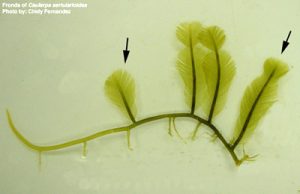 |
| Fronda |
Parte del talo de las algas similar a las hojas. |
| Fusiform |
Spindle-shaped or centrally thickened and tapering to both ends; also appearing like a cigar or a spindle (based upon the Latin, fusus (spindle) & forma (shape); cf. fus-, fusiformis, fusoid & spindle-shaped). |
|
| Fusiforme |
Con forma de huso, que se adelgaza gradualmente por ambos extremos. |
|
| Gametangium |
A cell in which gametes are formed. |
|
| Gametangio |
Célula o estructura multicelular que produce gametos, en algas y hongos generalmente unicelular. |
|
| Gametophyte |
A plant which is genetically constituted to produce gametes. A plant from the sexual phase of alternation of generations. |
|
| Gametófito |
Planta productora de gametos haploide. En una planta que presenta alternacia de generaciones, la generación que produce gametos. |
|
| Genus |
The smallest natural or releated groupin of plants containing distinct species (Pl. = genera). |
|
| Género |
Categoría taxonómica que reúne a varias especies emparentadas. |
|
| Gonimoblast |
A microscopic carposporangium-producing filoament growing from the carpogonium or from an auxiliary cell (Rhodophyta). |
|
| Gonimoblasto |
Filamento dentro del carpoesporangio que sostiene las carpoesporas. |
|
| Habit |
General aspect of a plant or its mode of growth. |
|
| Hábito |
Aspecto general de la planta o modo de crecimiento. |
|
| Heteromorphic |
Displaying two different life forms, each with a different habit or appearance. Ant. = isomorphic. See pleomorphic. |
|
| Heteromórfico |
Plantas que presentan dos diferentes formas de vida, cada forma con diferente hábito o apariencia. Antónimo de isomórfico. |
|
| Holdfast |
A cell or group of cells modified to act as an organ of attachment. May attain considerable size. |
|
| Sujetador |
Porción del talo que se ancla en el sustrato. |
|
| Iridescent |
Surface sheen reflecting an interplay of metallic color, shinning. |
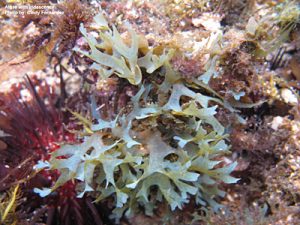 |
| Iridicente |
Superficie que refleja colores metálicos. |
| Isomorphic |
Of like appearance. Displaying two generations with similar form or appearance. Ant. = heteromorphic. |
|
| Isomórfico |
Plantas que presentan dos formas de vida de apariencia y forma similar. Antónimo de Heteromórfico. |
|
| Lacerate |
Irregularly cleft or cut; also being torn along the margin. |
|
| Lacerado |
Con los márgenes irregularmente desgarrados o cortados, rasgados a lo largo de los bordes. |
|
| Macroscopic |
Large enough to be seen with the naked eye. |
|
| Macroscópico |
Tamaño de un organismo o estructura el cual se puede observar a simple vista. |
|
| Marginal |
At the edge or margin. Barely suitable; as, marginal conditions. |
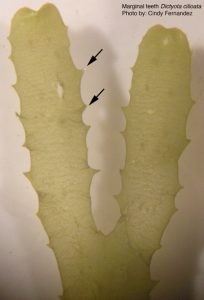 |
| Marginal |
Relativo a o cerca del margen del borde. |
| Medulla |
A differentiated central core of tissue surrounded by the cortex, in a more or less solid alga. |
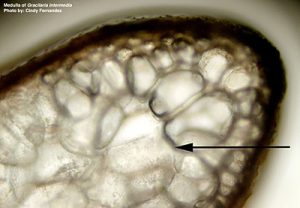 |
| Médula |
Porción central de los talos parenquimatosos. |
| Medullary |
Situated in or belonging to the medulla. |
 |
| Medular |
Relativo a la médula. También se refiere a los tejidos o estructuras situadas en el centro de un talo |
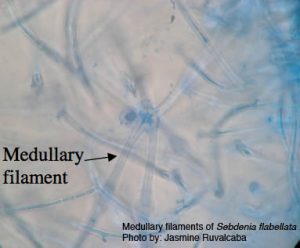 |
| Midrib |
Center vein-like structure of a blade. |
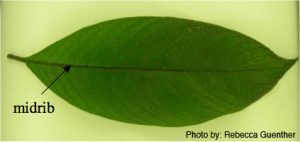 |
| Nervadura |
Línea fina de células centrales, la lámina es más gruesa en esta parte que en cualquier otra. Visible a simple vista o no. |
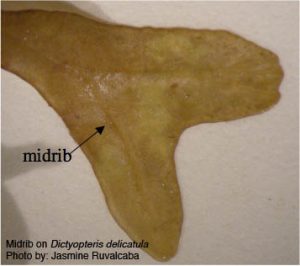 |
| Moniliform |
Alternately swollen and contricted, arranged like a string of spherical beads. |
|
| Moniliforme |
Células dispuestas como una cadena de cuentas, como un collar, donde se dan constricciones repedidas de formas globosas. |
|
| Multiseriate |
In several columns or rows, as a filament several cells thick; also being more than two cells (or loculi) wide (cf. biseriate, pluriseriate & uniseriate). |
|
| Multiseriado |
Talo o estructura con aspecto filamentoso, consisten en varias hileras de células en series longitudinales y en uno o en dos planos. |
|
| Opposite |
A type of branching in which there are two pinnules or branchlets at a node, usually placed 180 degrees apart. |
|
| Opuesto |
Tipo de ramificación, donde dos ramas o pínulas están colocadas en lados contrarios, generalmente a 180 grados. |
|
| Pericarp |
The urn-shaped sterile envelope surrounding a cystocarp or carposporophyte (Rhodophyta). |
|
| Periocarpo |
Capa o envoltura de células vegetativas estériles, que encubren u ocultan y casi siempre oscurecen a un carpoesporófito, cistocarpo o gonimoblasto. |
|
| Pericentral cell |
One of a ring of cells cut off from and surrounding the central (axial) cell. (Rhodophyta: Rhodomelaceae) Plants with an axial cell row and pericentral cells are termed poysiphonous. |
|
| Célula pericentral |
Célula alrededor o cerca del centro, formada por una célula axial y central en las Rhodomelaceae. |
|
| Pit connection |
A cytoplasmic strand connecting two adjoining cells through a pit in their respective cell walls. (Rhodophyta, Cyanophyta). |
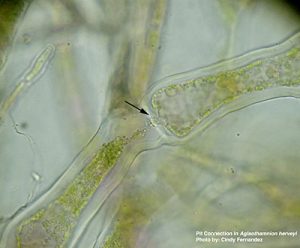 |
| Conexiones pit |
Remanente de la pared celular que une dos células de manera longitidinal o perpendicular, presente en Rhodophyta y Cyanophyta. |
| Plurilocular sporangia (Phaeophyta) |
Multicelled sporangia borne only on diploid plants. The reproductive products are diploid flagellated zoospores which, on release, develop into new diploid plants. A morphologically equivalent organ borne on haploid thalli is sometimes called (incorrectly) a plurilocular sporangium, but it is in fact a gametangium producing biflagellate gametes. |
|
| Esporangio Plurilocular |
Estructura multicelular en la cual se forman las esporas. La fase esporangial de un ciclo de vida produce esporas diploides. |
|
| Pluriseriate |
In more than one series or row. |
|
| Pluriseriado |
Células o filamentos dispuestos en más de una fila o serie. |
|
| Pneumatocyst |
A cell or cellular structure filled with gas, to hold the photosynthetic portion of a plant toward the direction of light. A bladder. An air-vesicle. |
|
| Neumatocisto |
Ver aerocisto. |
|
| Polysiphonous |
Consisting of a finite number of cells (pericentrals) cut off from tand surrounding each cell in the axial cell row. Consisting of several coherent longitudinal rows of cells. (Rhodophyta: Rhodomelaceae). |
|
| Polisifónico |
Talo formado por varias células dispuestas alrededor de una célula central. |
|
| Prostrate |
Lying flat upon the substratum; also growing along (parallel) and often adherent to the substratum (cf. pronate, prone, prostrate habit & prostratus). |
|
| Postrado |
Talos que están dispuestos aplanados sobre el sustrato, tendidos o que se arrastran sobre sustrato. |
|
| Pyrenoid |
A refractile cytoplasmic body generally associated with the chloroplasts of green algae, and involved with the production or storage of starch. Also mentioned in connection with other divisions of algae, but here not involved with starch. |
|
| Pirenoide |
Cuerpo proteico altamente refractivo, presente en los cloroplastos. Su función es ser el centro de la síntesis y formación de almidón. |
|
| Repent |
Creeping along the substratum. |
|
| Ripario |
Tipo de crecimiento rastrero. |
|
| Reticulum |
A network. |
|
| Reticulado |
En forma de red. |
|
| Rhizine |
Filaments composed of slender, thick-walled cells which penetrate the medulla (Rhoodphyta, as in the genera, Gelidium and Pterocladia). Infrequently called hyphae. |
|
| Rizines |
Filamentos de células delgadas y alargadas con paredes gruesas, hialinas de apariencia flexible en la médula de algunas Gelidiales. |
|
| Rhizoid |
A one- to many-celled filament or cell extension, serving mainly as an organ of attachment. |
|
| Rizoide |
Estructura de fijación, multicelular filamentosa, generalmente incolora más pequeña que un órgano de fijación. |
|
| Rhizoidal |
Pertaining to the rhizoids. Rootlike. |
|
| Rizoidal |
Que pertenece a un rizoide. |
|
| Rhizome |
A prostrate axis producing roots or their analogs, as well as foliar organs. |
|
| Rizoma |
Estructura como raíz, parecida a un tallo grueso horizontal o como eje postrado y engrosado. |
|
| Saccate |
Pouched, balloon-shaped, or appearing like a sack (cf. sacciform, sac-like & saccus). |
|
| Globoso |
Con forma de saco o de bolsa. |
|
| Siphonaceous |
Composed of tubes or siphons, generally multinucleated. |
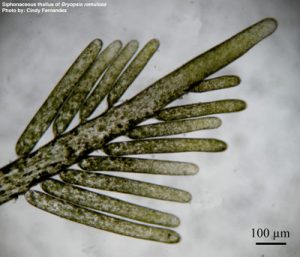 |
| Sifonáceo |
Tipo de talo filamentoso tubular y multinucleado, que no presenta paredes internas. |
| Spermatangium |
Male gametangium forming one spermatium in the Rhodophyta. |
|
| Espermatangio |
Célula que produce un solo espermacio o gameto masculino sin flagelo en las Rhodophyta. |
|
| Spermatium (Pl. = spermatia) |
The near colorless non-flagellated male gamete. (Rhodophyta) |
|
| Espermacio |
Gametos masculinos sin flagelo que se forman en el espermatangio. |
|
| Spermatozoid |
A flagellated male gamete. |
|
| Espermatozoo |
Gameto masculino flagelado. |
|
| Sporangium |
A cell in which spores are produced. |
|
| Esporángio |
Estructura en la cual se forman reproductores de tipo meoótico. La fase esporangial de un ciclo de vida produce esporas, generalmente haploides. Los esporangios pueden ser uniloculares o pluriloculares. |
|
| Spore |
A one-celled reproductive product, with or without a wall, and with or without motility. Spores are specialized for propagation and are capable, without fusion with any other cell, of growing into a new plant. Spores may be the product of mitosis (mitospores) or meiosis (meiospores). |
 |
| Espora |
Estructuctura reproductiva unicelular producto de la mitosis o meiosis, pueden o no tener pared, móviles (zoosporas) o inmóviles (monosporas, aplanosporas, carposporas, tetrasporas). |
| Sporophyte |
The spore-producing, usuall diploid, phase of an algal life history, alternating with the gametophyte generation. |
|
| Esporofito |
Fase esporangial diploide en un ciclo de vida. |
|
| Terete |
Cylindrical, and circular in cross section. |
|
| Cilíndrico |
Forma circular en corte tranversal del talo. |
|
| Tetrasporophyte |
A macroscopic diploid generation that produces tetraspores by meiotic division in a tetrasporangium (Rhodophyta). |
|
| Tetraesporofito |
Fase esporangial diploide en el ciclo de vida de las rodofitas, el cual produce tetrasporas por división meiotica en un tetraesporangio. |
|
| Thallus (Pl. thalli) |
A relatively undifferentiated plant body that is not divided into true roots, stems, and leaves. Commonly used to refer to the plant body of any alga. |
|
| Talo |
Agrupación celular mas sencilla que presentan las algas, carente de raíz, tallo, hojas o tejidos conductores, solo presentan: rizoide para fijarse, estipeo o cauloide y frodas, láminas o filoides semejantes a hojas. |
|
| Trabecula |
In botany the term trabeculum is used to describe cross-connections or a strand of cell-wall material crossing a space within a plant or cell (mainly in coenocytes); based upon the Latin word trabecula, a little beam- cf. micromeres & trabecule. See Caulerpa |
 |
| Trabécula |
Parte de la pared de una célula con forma de barra, en las Caulerpaceae son fibras que recorren el filamento. |
| Trichoblast |
A filamentous lateral outgrowth, consisting of a single row of unpigmented cells, usually much branched, borne on and derived from the surface layer of a thalls. (Rhodophyta; Rhodomelaceae). |
|
| Tricoblasto |
Célula epidérmica que origina un filamento como pelo radicular que puede ser incoloro, simple o ramificado. |
|
| Trichogyne |
The hairlike, receptive, apical prolongation of a carpogonium (Rhodophtya), with which a spermatium fuses as the beginning of fertilization. |
|
| Tricogino |
Célula receptiva de los espermacios con forma de pelo apical en las rodofitas y clorofitas, situada en el extremo de la estructura sexual femenina o carpogonio. |
|
| Truncate |
With an end abruptly flattened as if cut (broken) off; also ending abruptly or cut off subapically (based upon the Latin, truncare (to shorten by cutting off). |
|
| Truncado |
Que termina bruscamente como si la punta estuviese cortada. Del latin truncare (hacerlo pequeño por un corte). |
|
| Turflike |
A term used to define the short, intwined, tightly adhereent, and often wiry community of plants growing on inter- and sub-tidal rocks, especially in exposed places. Syn. = tapetic. |
|
| Césped algal |
Forma de crecimiento donde hay muchas especies de algas fillamentosas entremezcladas. |
|
| Uniseriate |
Arranged in a single row or series. |
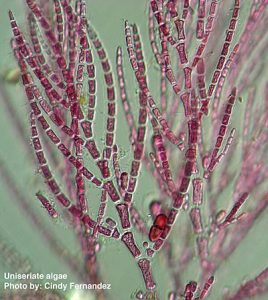 |
| Uniseriado |
Tipo de filamento con una sola fila o hilera de células en grosor. |
| Utricle |
The swollen end of a filament forming a cortical stratum at the surface. A small sac-shaped organ. |
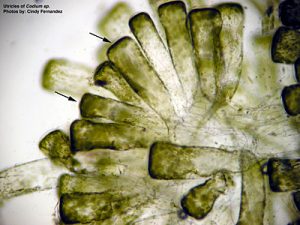 |
| Utrículo |
Célula epitelial inflamada. |
| Verticillate |
Branching in a flat whorl, radiating outward in al directions in a single plane. |
|
| Verticilado |
Conjunto de tres o más ramas que salen de un mismo punto en su eje. |
|








































